Tenth Stalinist strike: Petsamo-Kirkenes operation
prehistory
In 1944, the Soviet army conducted a series of strategic offensive operations - the so-called "10 Stalinist strikes." As a result, Germany and its allies suffered a decisive defeat, and the Red Army almost completely completed the liberation of their native land.
During the Vyborg-Petrozavodsk operation of the summer of 1944 of the year (fourth strike), the Soviet troops finally eliminated the threat of Leningrad from the side of the German-Finnish troops, broke through the “Mannerheim Line”, liberated Vyborg and Petrozavodsk. Seeing the inevitable defeat of Hitler's Germany and having suffered a heavy defeat from the Red Army troops, the government of Finland on the night of September 4 announced that it was accepting Moscow’s offer of a truce. 19 September The Finnish delegation signed an armistice agreement with representatives of the USSR and the UK in Moscow. At the same time, the Finnish government has committed itself to expel or intern German forces in Finland. Wehrmacht troops retreated to Petsamo and to Northern Norway, to Kirkenes.
The Germans were not going to leave the territory of Northern Finland and Norway. The German military-political leadership was going to keep these areas behind, since nickel and copper, strategic resources for the German military-industrial complex, were taken from here. In addition, there were military-operational factors. Control over these areas made it possible to hold naval and aviation bases in the Far North, which were of strategic importance. Hitler even had a program to capture the Arctic. These bases allowed threatening Soviet sea communications in the North.
The German command was ready to leave Finland from the war. In the summer of 1943, the German High Command began to make plans for a possible separate peace treaty between Finland and the Soviet Union. In the area of Petsamo - Nickel, it was decided to concentrate a separate grouping. During the winter 1943 — 1944. through the labor of prisoners of war, a road network was established between the northern regions of Norway and Finland. It also created a network of warehouses with everything you need. At the same time, the construction of additional fortifications of the Lapland (“granite”) shaft went on.
In the prevailing military and political conditions, the presence of the Germans in Finland was dangerous for the Finns, because it violated the terms of the agreement with Moscow. Fearing that the Soviet Union would point out Finland’s failure to comply with the agreement’s points and possible negative consequences, Helsinki began military operations against the German troops (the so-called Lapland War). In late September, Finnish troops attempted to expel the Germans from the coastal cities of Kem and Tornio. In early October, Finnish troops managed to do this. After which the Finns launched an offensive against the city of Rovaniemi. German forces under the command of General Lothar Rendulich (he led units of the 20 mountain army) responded with the scorched-earth tactics, leaving behind destroyed and burned villages. The Germans devastated vast areas of northern Finland, where more than a third of the housing stock was destroyed. They wiped out the city of Rovaniemi.
This aroused hatred in the Finnish population. Deceived earlier by official propaganda, many Finns understood who their real enemy was. Finns began to actively help their troops to oppose the enemy. By the end of October, Finnish troops dismembered the enemy group in two. One part of the German troops moved to the north-west, where it retained control over the Kilpisjärvi area near the Norwegian border. The other part occupied positions at Lake Inari, closing the road to Petsamo.
German defense
Meanwhile, Soviet troops entered the pre-war border with Finland. The commander of the Karelian Front, Kirill Meretskov, noted that the enemy relied on a deep-echeloned defense with long-term structures - powerful reinforced concrete and granite fortifications. The offensive complicated the difficult nature of the terrain (rocky hills, fjords, lakes, rivers, swamps and forests), which the Germans competently used to strengthen their defenses.
For three years the Germans built a Lapland (“granite”) defensive wall here. The defense system of the German army included the 3 bands: 1-I was on the site Volokovaya Bay Small - the southern coast of Motovka Bay - the western shore of the lip Face Zap. - lower reaches Persons Zap. - headwaters Titovka, 2-I - on the river. Titovka, 3-I (rear) - on the river. Petsamo-yoki (Pechenga). The length of the defensive line reached 100 km, depth to 150 km. Fortifications consisted of reinforced concrete and armored fire points, minefields, anti-tank ditches. All strongholds were adapted for all-round defense. Especially strongly were strengthened boundaries on the river. Persons Zap. (length 40 km, depth 8 km) and on the isthmus of the Medium Peninsula (length 9 km, depth 3 km).
With the withdrawal of Finland from the war, the Germans undertook additional engineering work, which took on a hectic character. Soviet intelligence and partisans constantly reported that the special engineering and construction units of the enemy literally bite into granite all day and night, erect new reinforced concrete and armored firing positions and shelters, lay trenches and message posts, create barriers and cover the main directions with minefields. Stone battles and anti-tank ditches, minefields and wire barriers stretched in front of the Soviet troops at the front near 100 for km. German fortifications blocked all mountain passes, ravines, roads and trails. The heights dominating the terrain were turned into real modern fortresses. From the sea, the fortified area was covered by coastal and anti-aircraft artillery, which had caponiers. In addition, from the sea, German troops supported a strong naval forces. The movement of the Soviet troops was hampered by numerous lakes, rivers, streams, swamps, chains of impregnable rocks, etc.
Based on this powerful defensive wall, the German command hoped to retain the northern regions of Finland and Norway. So, the Soviet intelligence intercepted the order of the commander of the 2 th mountain-jäger division, Lieutenant General Dagen, in which the German commander, referring to the order of Adolf Hitler, noted the need to keep the region of Northern Finland at all costs. The order noted that Russian troops would be exhausted by fruitless attempts to break through strongly fortified strongholds, and then destroyed by counter-attack.
The front defended the 19 th German mining and chasseurs corps under the command of the General of the Mountain Forces Ferdinand Jodl from the 20 th Mountain Army. The corps included 3 mountain divisions and 4 brigades. Total Lapland shaft defended 53 thousand people, 770 guns and mortars, with the support of 160 aircraft from the 5-th air fleet. German ground forces supported significant naval forces that were based in the ports of Northern Norway (1 battleship, 12-14 destroyers, up to 30 submarines and other ships, just up to 20 ships and ships).
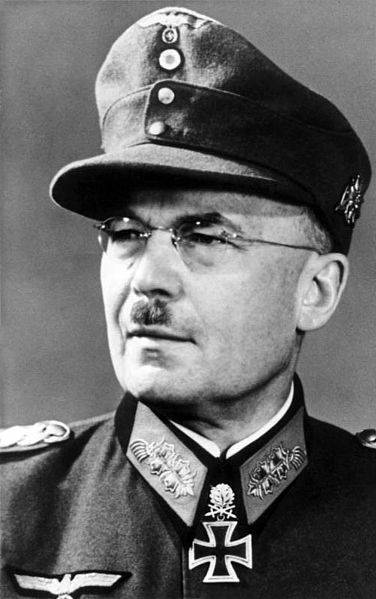
The commander of the 20 mountain army Lothar Rendulich
Soviet forces. Operation plan
The 14th Army under the command of Lieutenant General Vladimir Shcherbakov consisting of 5 infantry corps and 1 operational group (8 infantry divisions, 6 separate infantry divisions, 2 engineering and 1 tank brigades). In total, the army numbered about 100 thousand people, more than 2,2 thousand guns and mortars, over 100 tanks and self-propelled guns. Ground forces supported the forces of the 7th Air Army under the command of Ivan Sokolov (689 aircraft). The Northern Fleet (commander Admiral Arseniy Golovko) also participated in the operation: over 20 thousand people, more than 250 ships and ships, 276 naval aircraft. Direct participation in the operation involved 2 brigades of the marine corps, detachments of ships (6 destroyers, 8 submarines, more than 40 torpedo boats and hunters).
The plan of operation was developed by the command of the Karelian Front. The main plan of the operation was to surround and destroy the main enemy forces by means of their deep coverage from the south and simultaneous strikes from the north. Then they planned to capture Petsamo and develop an offensive towards the Norwegian border. The offensive of the 14 Army on the coastal flank should have been facilitated by the tactical landings of the Northern Fleet.
The main blow was inflicted by the forces of the left wing of the 14 Army from the area south of Lake Chapr (Chap) in the direction of Luostari and Petsamo (Pechenga). On the right wing of the 14 Army, a specially formed task force was assigned the task of chaining enemy troops by battle, and then with the support of the marine brigades to strike at Petsamo. The Northern Fleet was to land the landing forces in the rear of the German troops, disrupt the enemy’s naval communications. Also among the tasks of the fleet was to support the advance of ground forces on the coastal flank with ships and aviation fire, blockade the ports of Petsamo and Kirkenes and ensure the freedom of navigation in the Barents Sea.
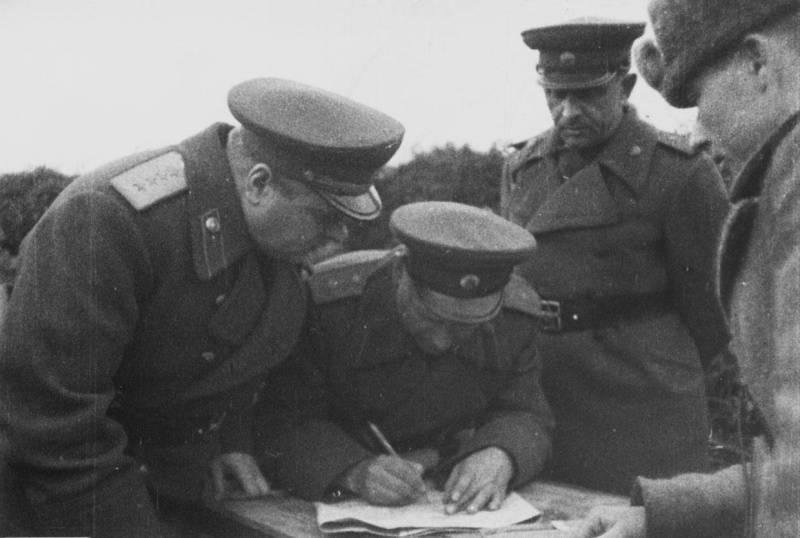
Commander of the Karelian Front, Army General K.A. Meretskov and the commander of the 14 Army, Lieutenant-General V.I. Shcherbakov during the Petsamo-Kirkenes operation. October 1944 of the year
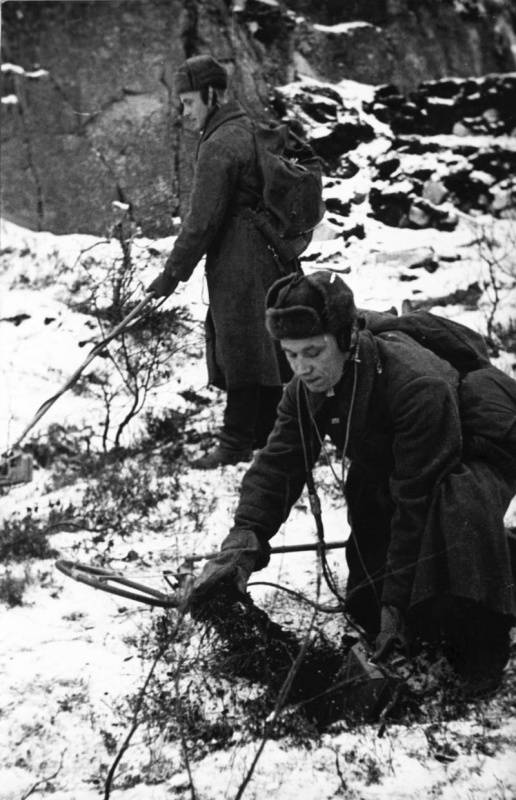
Soviet sappers demine territory during the Petsamo-Kirkenes offensive operation
Soviet offensive
On 8 in the morning of October 7, 1944, a strong artillery preparation began. For two and a half hours Soviet artillery struck enemy positions. Due to bad weather conditions (wet snow fell), the flight had to be canceled. In 10.30, artillery fire was moved deep into enemy defenses, and the Soviet infantry went on the attack.
The offensive in the area of the 131 rifle corps was developing most successfully. On the very first day, the corps broke through the main line of defense of the enemy and reached the Titovka River. Soviet troops forced the river and captured the bridgehead. Then the corps fought to expand the bridgehead and launched an attack on Petsamo from the southeast.
The 99 th rifle corps, which also attacked in the first echelon of the army, could not capture the main strongholds of the enemy on the first day. Then the corps commander, Major-General S.P. Mikulsky, made a non-standard decision — he launched a second offensive at night. Meretskov wrote: "Exactly in 24.00, cursing the light of the Nazis and the bad weather, the soldiers rushed forward, and this time the Nazis could not stand." By morning, the front edge of the enemy defenses was occupied by Soviet troops. Parts of the 99 Corps crossed the Titovka River and took part in the liberation of Luostari. Then the corps launched an offensive on Petsamo from the south. On October 14, in the offensive zone of the 99 Infantry Corps, the 7 Guards Tank Brigade was brought into battle.
On October 9, the operational group under the command of Lieutenant-General B. A. Pigarevich launched an offensive. It was advancing from the area east of the River West Persons, in the place of the greatest advance of the German troops on the Murmansk direction.
Landing in the bay Malaya Volokovaya. That same night, the Northern Fleet joined the struggle. In the evening of October 9, detachments of ships with troops on board left the concentration points. Amphibious assault forces (a marine brigade) were planned to land on the southern shore of the Malaya Volokovaya Bay (Mattivuono). The landing force was to seize the bridgehead and go to the rear of the enemy troops, who blocked the Soviet troops on the Middle Peninsula and together with the forces of the Karelian Front to defeat the Nazis.
First, a diversionary landing force (44 soldier) and a sabotage detachment (near 200 fighters), which was supposed to go to the rear of the German batteries on Cape Krestovy near Linahamari, were landed in the Pikshuev cape. On the night of October 10, the landing of the main forces began - more than 2 of thousands of marines from the 63 Brigade of the Marine Brigade under the command of Colonel A. M. Krylov. The operation involved more than 30 boats. Artillery support carried out two destroyers. The detachment quickly occupied a springboard. During the landing, units of the German coastal defense were destroyed. The losses of the Soviet troops were insignificant (a few people). The success of the operation contributed to a thorough preliminary reconnaissance of German positions.
At the same time, Soviet forces launched an offensive from the side of the Middle Peninsula. Early in the morning, artillery preparation began and in 5: The 00 landing force and the 12-I brigade of marines from the Middle Peninsula went on the offensive. Destroyers also took part in artillery training. The battle took on an extremely fierce character, often turning into hand-to-hand combat. Many important heights and fortifications had to be taken by storm. The defense of the enemy was broken, and in the middle of the day a hasty departure of the German group began, which occupied these positions for more than three years. On the night of October 11, the isthmus of the Rybachiy peninsula was completely liberated by Soviet troops. In the morning of October 12, the ode of the marine brigade began to develop an offensive against Pechenga. October 13 paratroopers crossed the Soviet border. The success of the landing operation was associated with good reconnaissance work, thorough preparation of the paratroopers (the units allocated to the landing force were engaged in combat training in the reserve for a long time) and well-established interaction between the landing forces and the fleet.
Landing in Linahamari. The Soviet forces conducted another successful landing during this operation. In the course of the operation, the Soviet command decided to seize the port of Linahamari. This port was one of the most important naval bases of the German fleet on the coast of the Barents Sea and the main transit point for the export of nickel from deposits in the Petsamo area. In addition, one of the frontiers of the German defense on the way of the Soviet troops to Norway passed here. This enemy stronghold had to be quickly picked up so that there were no delays in the overall offensive of the Karelian Front.
The port and harbor of Linahamari represented a whole fortified area. The narrow and deep-water entrance to the Petsamovuono fjord was excellent at shooting. At its entrance and in the harbor the Germans prepared a multi-layered system of artillery and machine-gun fire. From the entrance to the fjord and to the port, you had to go 18 miles under heavy enemy fire. Here the Germans installed 4 coastal 150 batteries and 210 mm guns, 20 batteries 88 mm millimeter anti-aircraft guns, which could fire on both air and sea and land targets. The port was equipped with reinforced long-term firing points. The battery of 150-millimeter guns (4 guns) at Cape Krestovy was considered key. The German battery kept shelling the whole of Petsamovuono Bay and the harbor of the port of Linahamari. The 4-x anti-aircraft gun 88-m guns were located nearby.
October 9 1944, in the Bay of Punainen-laht, a special landing force (about 200 fighters) was landed a few dozen kilometers from the target. It consisted of the reconnaissance detachment of the Northern defensive region under the command of Major I. P. Barchenko-Emelyanov and the 181 Special Forces Division of the Northern Fleet, Lieutenant V. N. Leonov. The reconnaissance and sabotage detachment with the observance of a thorough disguise made a hidden march to the target. October 12 after a short battle 181-th special purpose detachment seized a battery of anti-aircraft guns at Cape Krestovo. A large number of prisoners were captured. The Germans landed troops and tried to fight off the battery. However, Leonov's detachment, together with the fighters of Barchenko-Emelyanov, repelled the attack and captured another 60 man.
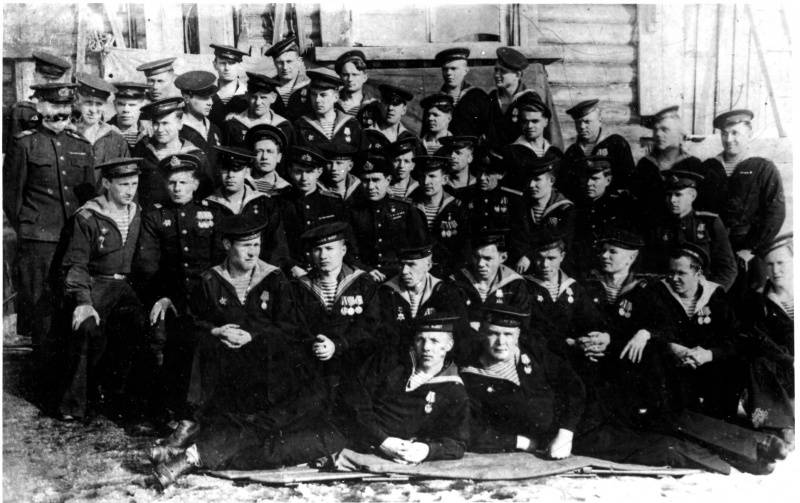
181-th special reconnaissance detachment of the Northern Fleet after the capture of Cape Krestovogo
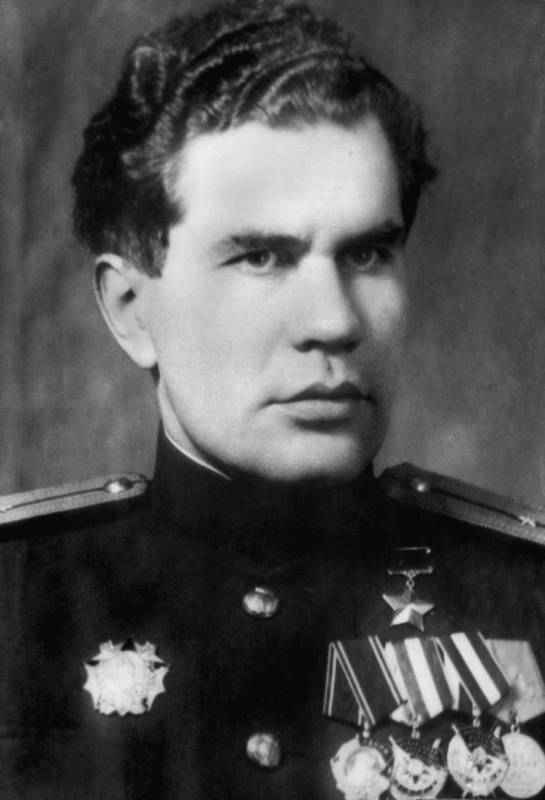
Hero of the Soviet Union Commander of the 181 Special Reconnaissance Unit of the Northern Fleet V. N. Leonov
Barchenko-Emelyanov’s detachment could not immediately capture an enemy battery, the battle took on an extremely tenacious and dramatic character. However, Soviet intelligence officers were able to block 150-mm enemy guns. As a result, this battery could not prevent the breakthrough of the Soviet landing in the harbor. The Germans then blew up their guns. On the morning of October 13, when the reconnaissance detachment was reinforced by a company from the 63 navy brigade, the remnants of the German garrison (78 man) surrendered. In general, the Soviet diversionary detachment lost 53 man killed and wounded.
This landing operation played a crucial role in overall success. In the evening of October 12 began the breakthrough of the boats with the landing force (660 fighters). Boats left the Rybachy Peninsula. The assault force was made up of soldiers from the 349-nd separate machine-gun battalion, the 125-th regiment of the marine corps and volunteer sailors. Commander of the landing forces was the commander of the machine-gun battalion, Major I. A. Timofeev. The detachment of boats was divided into three groups: advanced breakthrough forces - 2 torpedo boats, the first echelon of troops - 5 torpedo boats, the second echelon - 1 torpedo boats and 6 patrol boats.
Under enemy fire (the Germans discovered Soviet boats at a distance of 20-30 cable from the entrance to the bay), the boats crossed the barrage zone and entered the fjord - they called it “the corridor of death”. Without reducing speed, the boats broke into the harbor, approached the berths and landed the paratroopers. After that, the boats left the harbor to leave the German fire zone. Two boats were damaged, but were able to leave. One patrol boat ran aground and its crew joined the landing party. During the cruel battle, which often turned into hand-to-hand combat, the Soviet paratroopers cleared the port by dawn of 13 October. The whole day was a stubborn battle. The German garrison, relying on a number of important strongholds in the vicinity of the port, went on to counterattacks. The landing party was supported by long-range artillery fire from the Middle Peninsula, as well as by aircraft.
During the day the battle paratroopers captured several strongholds of the enemy. On the night of October 14 and in the morning at Linahamari, the Soviet command deployed significant reinforcements. During this day, the vicinity of the port and important roads along the coast were occupied by Soviet troops. The bold idea led to complete success. The Germans lost the opportunity to evacuate their forces through the port of Linahamari. This operation facilitated the assault on Petsamo. Soviet troops and navy received an important base and supply point. This operation was carried out at a high level and ended with the complete victory of the Soviet forces. Marines and scouts showed the highest heroism, the commanders of boats and detachments of high skill.
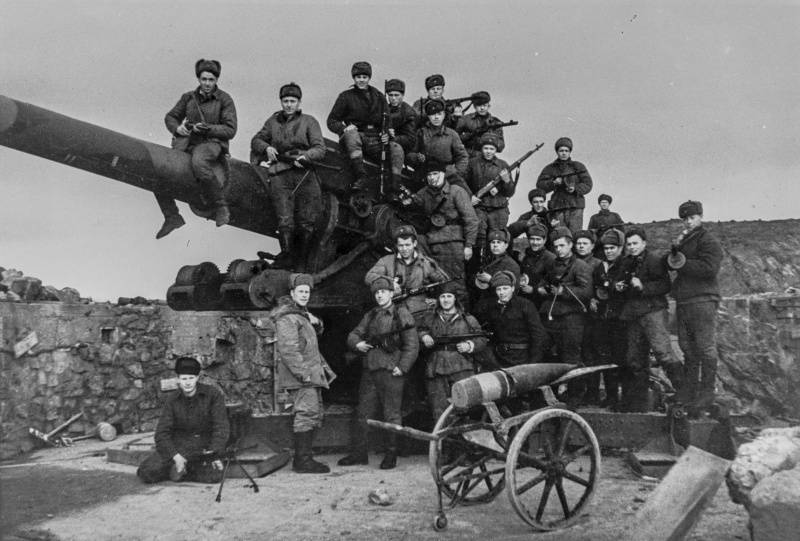
Soldiers of the Northern Fleet 12 Brigade in the firing position of the captured German coastal battery HKB 2./773 in Liinakhamari (Petsamo-fiord). In the frame 21 cm K39 / 40 cannon (210-mm cannon of the Škoda concern). The HKB 2./773 battery was used in counter-battery combat with Soviet artillery.
Successfully attacked and other connections of the front. On the left flank, the 126 th light mountain rifle corps successfully made a deep detour through hard-to-reach positions and entered the area west of Luostari. Here, the Germans had only focal defense, relying on the inaccessibility of swampy-river terrain, devoid of not only roads, but also trails. Soviet soldiers had to force icy water barriers and climb slippery granite rocks. On October 10, corps units intercepted the Petsamo-Salmijärvi road, preventing the German command from maneuvering forces and redeploying reserves. Corps led hard battles. The Germans fought back fiercely, went into counterattacks. The mountain rifle corps continued its attack on Petsamo from the south and October 13 cut the Petsamo-Tarnet road. Then the corps advanced along the Luostari-Akhmalahti road.
The 127 th light mountain rifle corps was in the second echelon of the 14 th army and had to support the advance of the 99 corps. October 12 put him into battle. The 127 body should be advancing in the general direction of Nickel. The corps troops captured the airfield in Luostari, and then, in cooperation with the forces of the 99 corps, cleared this town from the Nazis.
Already on October 12, Soviet troops reached the approaches to Petsamo. Petsamo was surrounded on all sides. From the east and north-east, the troops of the operational group and the 12-th brigade of marines attacked. From the north and north-west marines attacked. From the south, units of the 131 and 99 units were moving. October 15 troops of the Karelian Front, along with parts of the Northern Fleet captured Petsamo.
The defeated German troops retreated towards Norway. Meretskov, having learned about the withdrawal of our troops to the Norwegian border, reported this to Stalin and asked permission to pursue the enemy further. He outlined the considerations of the front command to seize Kirkenes, the main naval and air base of the Germans in the area. Stalin replied: “It would be good!” Thus began the second stage of the Petsamo-Kirkenes operation.
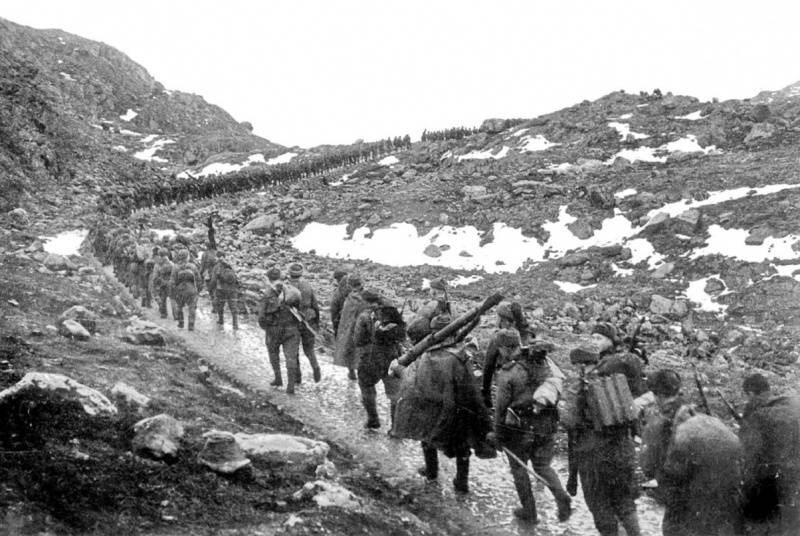
12 Fighters of the Red Banner Marine Corps Brigade of the Northern Fleet on the march through Musta-Tunturi Ridge
Kirkeness Liberation Operation
October 17 The 131 Rifle Corps reached the Norwegian border. October 22 Soviet troops liberated the city of Tarnet. 24-25 October Corps forced Beck Fjord. As Meretskov noted, the German troops, retreating to Kirkenes, increasingly used various barriers and destroyed roads, trying to stop the Soviet troops. The suspension bridge over the fjord was blown up, the roads were heavily mined. German rearguards delivered artillery and mortar strikes against Soviet advanced forces, preventing mine clearance and the restoration of communications. It really slowed down the pace of the offensive of the Karelian Front troops. Meretskov also noted that when crossing the fjords much help was provided by local residents.
The 99 Rifle Corps advanced along the Luostari-Ahmalahti road. October 22 corps troops took to the road Ahmalahti - Kirkenes, October 23 - crossed to the western shore of Lake Salmi-Järvi, freeing around Norwegian settlements 20. By the evening of October 24, corps troops approached Kirkenes.
The Northern Fleet, supporting the advance of the ground forces, conducted three tactical landing operations: landings in the gulfs of Suolavuono and Aresvono (October 18), in Cobholm Fjord (October 23), and in Holmengro-Fjord (October 25). All three landings were carried out successfully. The landing forces smashed the isolated units of the retreating enemy, liberated settlements, seized artillery positions, and ammunition depots. An assault force landed at Holmengro fjord (two battalions of marines - 835 man) took part in the storming of Kirkenes.
126 th October Mountain Light Rifle Corps 21 came out to Lake Klistervati, October 25 took part in the liberation of the Norwegian city of Munkelven. Corps troops advanced the most on the territory of Norway and on October 27 liberated the city of Neiden. The 127 th October Mountain Light Rifle Corps 22 of October took part in the capture of Nickel. The 31 th rifle corps, which was in the second echelon of the 14 th army and was brought into battle only at the second stage of the Petsamo-Kirkenes operation, also attacked Nickel. He took part in the taking of this locality. Then the troops of the corps did not force the Yar-Fjord Bay and began to pursue the retreating enemy units to the south. On October 27, corps troops liberated the settlement of Nautsi and reached the Finnish-Norwegian border, where they stopped.
On the morning of October 25, Soviet troops entered Kirkenes. The city was badly damaged. Retreating, the Nazis blew up all the port facilities, destroyed the administrative buildings and even the living quarters. Only on the outskirts of the city remained surviving houses. October 27 Soviet troops liberated Neiden. A further offensive was considered inexpedient. The harsh northern winter was approaching. Ahead lay a mountainous, impassable, entire rugged fjords area. The intelligence sent forward reported that further movement was associated with great difficulties, but there was no enemy. The frustrated German troops were no longer a threat and began to surrender to the masses of the Norwegian Resistance fighters in masses.
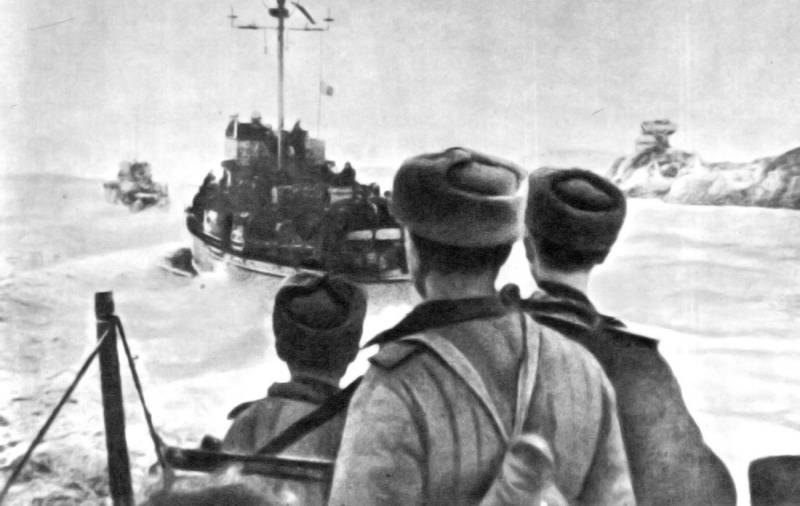
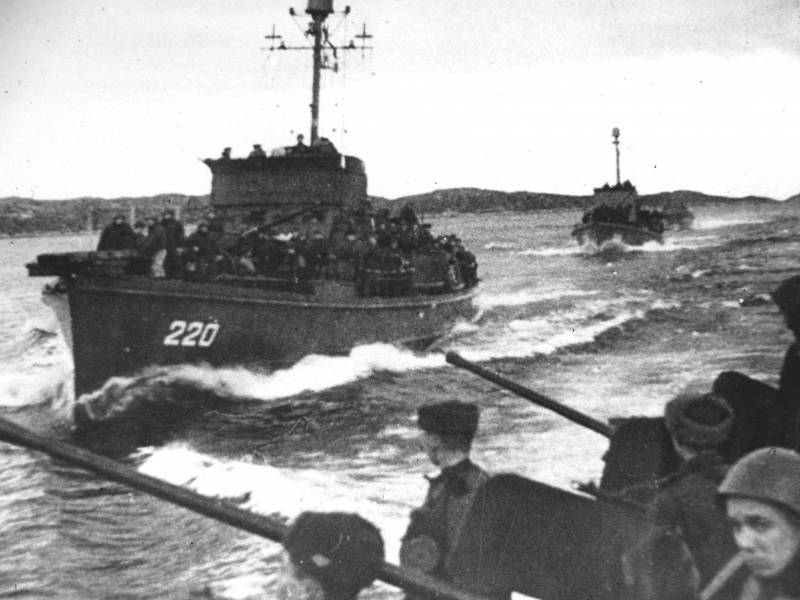
Ships of the Soviet Northern Fleet with paratroopers on the way to Kirkenes
Results
The Military Council of the Karelian Front decided to stop further offensive in connection with the implementation of the main objectives of the operation. On the night of October 29, Meretskov phoned Stalin and reported on the decision of the front command. The Supreme Commander announced that the proposal of the Military Council would be studied. Soon, Stalin announced that the proposal of the front command was approved. The troops received an order further to Norway not to move. The Karelian front received an order to reliably cover the main directions on the lines reached and to create strong reserves.
As a result of the Petsamo-Kirkenes operation, Soviet forces advanced westward by 150 km, liberated the Soviet Arctic (Petsamo-Pechenga region) and Northern Norway. The powerful defense of the enemy was hacked, its main strongholds captured. Soviet troops marked the beginning of the liberation of Norway from the German occupation. The liberated Norwegian territory was soon transferred to the legal authorities.
German troops only lost about 30 thousand people killed. The Soviet fleet and aviation sank more than 150 enemy ships and vessels. Aviation destroyed 125 German aircraft. Soviet troops lost about 21 thousand people. For the difference in the 51 battles, the compound and part of the Karelian Front were given the honorary names Pechenga and Kirkenes, the Soviet soldiers 56 were awarded the titles Heroes of the Soviet Union.
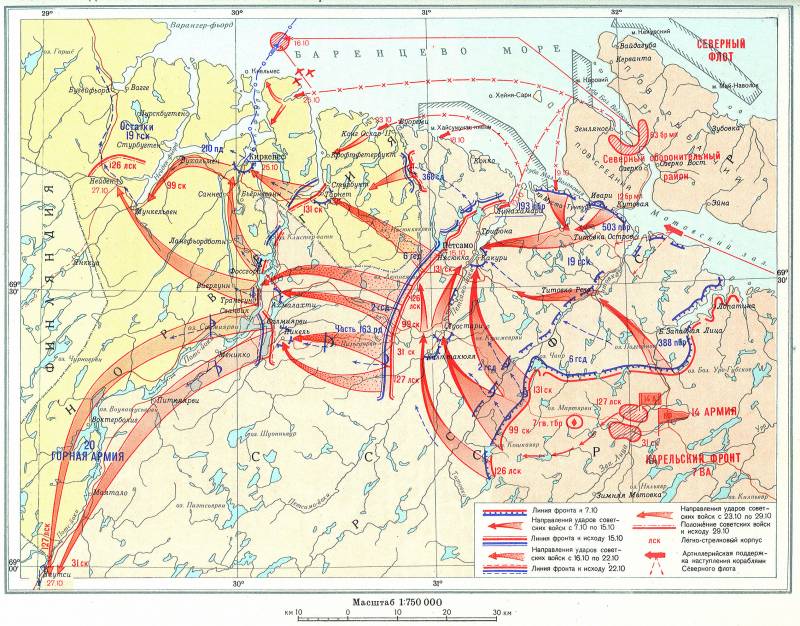
Information